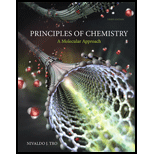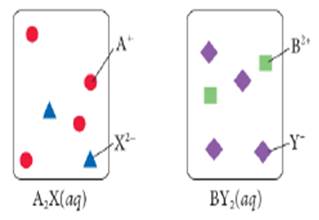
Concept explainers
Consider the generic ionic compounds with the formulas

Draw a molecular-level representation showing the result of mixing the two solutions above and write an equation to represent the reaction.
Want to see the full answer?
Check out a sample textbook solution
Chapter 4 Solutions
Principles of Chemistry: A Molecular Approach Plus Mastering Chemistry with eText -- Access Card Package (3rd Edition) (New Chemistry Titles from Niva Tro)
- What volume of 0.250 M HCI is required to neutralize each of the following solutions? a. 25.0 mL of 0.103 M sodium hydroxide, NaOH b. 50.0 mL of 0.00501 M calcium hydroxide, Ca(OH)2 c. 20.0 mL of 0.226 M ammonia, NH3 d. 15.0 mL of 0.0991 M potassium hydroxide, KOHarrow_forwardWhen 10. L of water is added to 3.0 L of 6.0 M H2SO4, what is the molarity of the resulting solution? Assume the volumes are additive.arrow_forwardA 25.0-mL sample of sodium sulfate solution was analyzed by adding an excess of barium chloride solution to produce barium sulfate crystals, which were filtered from the solution. Na2SO4(aq)+BaCl2(aq)2NaCl(aq)+BaSO4(s) If 5.719 g of barium sulfate was obtained, what was the molarity of the original Na2SO4 solution?arrow_forward
- Twenty-five mL of a 0.388 M solution of Na2SO4 is mixed with 35.3 mL of 0.229 M Na2SO4. What is the molarity of the resulting solution? Assume that the volumes are additive.arrow_forwardCitric acid, which can be obtained from lemon juice, has the molecular formula C6H8O7. A 0.250-g sample of citric acid dissolved in 25.0 mL of water requires 37.2 mL of 0.105 M NaOH for complete neutralization. What number of acidic hydrogens per molecule does citric acid have?arrow_forwardArsenic acid, H3AsO4, is a poisonous acid that has been used in the treatment of wood to prevent insect damage. Arsenic acid has three acidic protons. Say you take a 25.00-mL sample of arsenic acid and prepare it for titration with NaOH by adding 25.00 mL of water. The complete neutralization of this solution requires the addition of 53.07 mL of 0.6441 M NaOH solution. Write the balanced chemical reaction for the titration, and calculate the molarity of the arsenic acid sample.arrow_forward
- Describe in words how you would prepare pure crystalline AgCl and NaNO3 from solid AgNO3 and solid NaCl.arrow_forwardConsider a 13.0% solution of sulfuric acid, H2SO4,whose density is 1.090 g/mL. (a) Calculate the molarity of this solution. (b) To what volume should 100. mL of this solution bediluted to prepare a 1.10-M solution?arrow_forwardThe Behavior of Substances in Water Part 1: a Ammonia, NH3, is a weak electrolyte. It forms ions in solution by reacting with water molecules to form the ammonium ion and hydroxide ion. Write the balanced chemical reaction for this process, including state symbols. b From everyday experience you are probably aware that table sugar (sucrose), C12H22O11, is soluble in water. When sucrose dissolves in water, it doesnt form ions through any reaction with water. It just dissolves without forming ions, so it is a nonelectrolyte. Write the chemical equation for the dissolving of sucrose in water. c Both NH3 and C12H22O11 are soluble molecular compounds, yet they behave differently in aqueous solution. Briefly explain why one is a weak electrolyte and the other is a nonelectrolyte. d Hydrochloric acid, HCl, is a molecular compound that is a strong electrolyte. Write the chemical reaction of HCl with water. e Compare the ammonia reaction with that of hydrochloric acid. Why are both of these substances considered electrolytes? f Explain why HCl is a strong electrolyte and ammonia is a weak electrolyte. g Classify each of the following substances as either ionic or molecular. KCl NH3 CO2 MgBr2 HCl Ca(OH)2 PbS HC2H3O2 h For those compounds above that you classified as ionic, use the solubility rules to determine which are soluble. i The majority of ionic substances are solids at room temperature. Describe what you would observe if you placed a soluble ionic compound and an insoluble ionic compound in separate beakers of water. j Write the chemical equation(s), including state symbols, for what happens when each soluble ionic compound that you identified above is placed in water. Are these substances reacting with water when they are added to water? k How would you classify the soluble ionic compounds: strong electrolyte, weak electrolyte, or nonelectrolyte? Explain your answer. l Sodium chloride, NaCl, is a strong electrolyte, as is hydroiodic acid, HI. Write the chemical equations for what happens when these substances are added to water. m Are NaCl and HI strong electrolytes because they have similar behavior in aqueous solution? If not, describe, using words and equations, the different chemical process that takes place in each case. Part 2: You have two hypothetical molecular compounds, AX and AY. AX is a strong electrolyte and AY is a weak electrolyte. The compounds undergo the following chemical reactions when added to water. AX(aq)+H2O(l)AH2O+(aq)+X(aq)AY(aq)+H2O(l)AH2O+(aq)+Y(aq) a Explain how the relative amounts of AX(aq) and AY(aq) would compare if you had a beaker of water with AX and a beaker of water with AY. b How would the relative amounts of X(aq) and Y(aq) in the two beakers compare? Be sure to explain your answer.arrow_forward
- A 10.00-mL sample of a 24.00% solution of ammonium bromide (NH4Br) requires 23.41 mL of 1.200 molar silver nitrate (AgNO3) to react with all of the bromide ion present. (a) Calculate the molarity of the ammonium bromide solution. (b) Use the molarity of the solution to find the mass of ammonium bromide in 1.000 L of this solution. (c) From the percentage concentration and the answer to part b, find the mass of 1.000 L ammonium bromide solution. (d) Combine the answer to part c with the volume of 1.000 L to express the density of the ammonium bromide solution (in g/mL).arrow_forwardConsider the following generic equation OH(aq)+HB(aq) B(aq)+H2OFor which of the following pairs would this be the correct prototype equation for the acid-base reaction in solution? If it is not correct, write the proper equation for the acid-base reaction between the pair. (a) hydrochloric acid and pyridine, C5H5N (b) sulfuric acid and rubidium hydroxide (c) potassium hydroxide and hydrofluoric acid (d) ammonia and hydriodic acid (e) strontium hydroxide and hydrocyanic acidarrow_forwardonsider separate aqueous solutions of HCI and H2S04 with the same concentrations in terms of molarity. You wish to neutralize au aqueous solution of’ NaOH. For which acid solution would you need to add more volume (in mL) to neutralize the base? The HCI solution. The H2SO4 solution. You need to know the acid concentrations to answer this question. You need to know the volume and concentration of’ the NaOH solution to answer this question. c and d plain your answer.arrow_forward
 Chemistry: The Molecular ScienceChemistryISBN:9781285199047Author:John W. Moore, Conrad L. StanitskiPublisher:Cengage Learning
Chemistry: The Molecular ScienceChemistryISBN:9781285199047Author:John W. Moore, Conrad L. StanitskiPublisher:Cengage Learning ChemistryChemistryISBN:9781305957404Author:Steven S. Zumdahl, Susan A. Zumdahl, Donald J. DeCostePublisher:Cengage Learning
ChemistryChemistryISBN:9781305957404Author:Steven S. Zumdahl, Susan A. Zumdahl, Donald J. DeCostePublisher:Cengage Learning Chemistry: An Atoms First ApproachChemistryISBN:9781305079243Author:Steven S. Zumdahl, Susan A. ZumdahlPublisher:Cengage Learning
Chemistry: An Atoms First ApproachChemistryISBN:9781305079243Author:Steven S. Zumdahl, Susan A. ZumdahlPublisher:Cengage Learning
 General Chemistry - Standalone book (MindTap Cour...ChemistryISBN:9781305580343Author:Steven D. Gammon, Ebbing, Darrell Ebbing, Steven D., Darrell; Gammon, Darrell Ebbing; Steven D. Gammon, Darrell D.; Gammon, Ebbing; Steven D. Gammon; DarrellPublisher:Cengage Learning
General Chemistry - Standalone book (MindTap Cour...ChemistryISBN:9781305580343Author:Steven D. Gammon, Ebbing, Darrell Ebbing, Steven D., Darrell; Gammon, Darrell Ebbing; Steven D. Gammon, Darrell D.; Gammon, Ebbing; Steven D. Gammon; DarrellPublisher:Cengage Learning Introductory Chemistry: A FoundationChemistryISBN:9781337399425Author:Steven S. Zumdahl, Donald J. DeCostePublisher:Cengage Learning
Introductory Chemistry: A FoundationChemistryISBN:9781337399425Author:Steven S. Zumdahl, Donald J. DeCostePublisher:Cengage Learning





